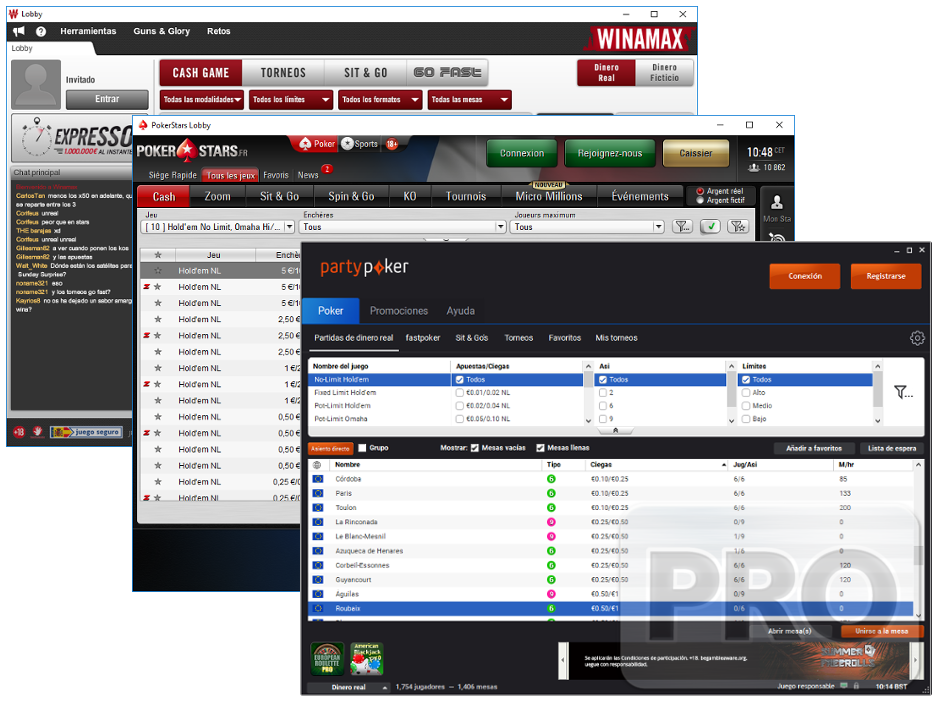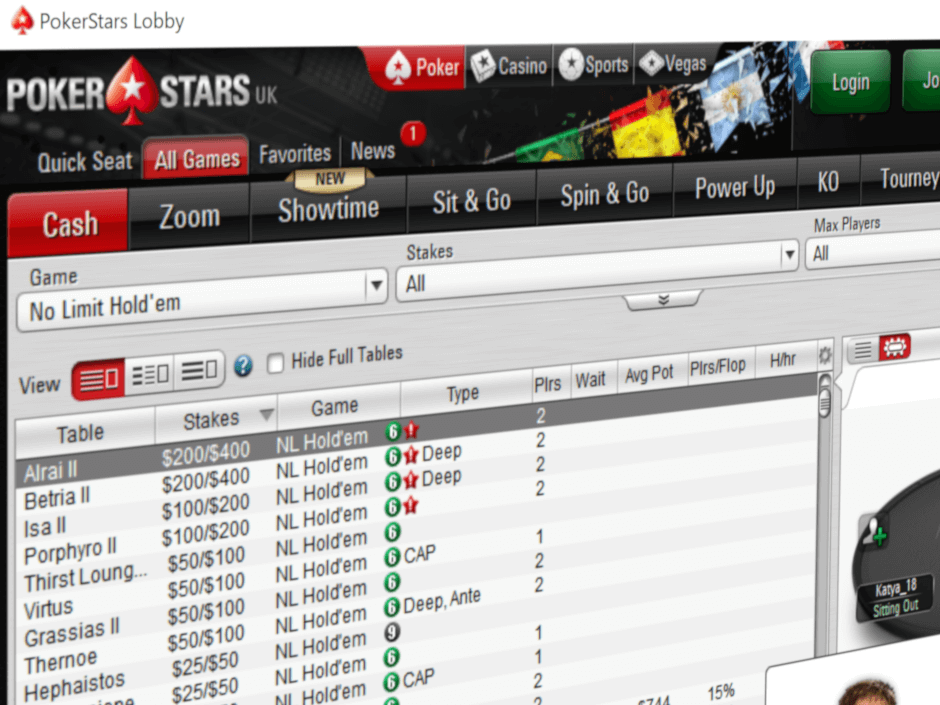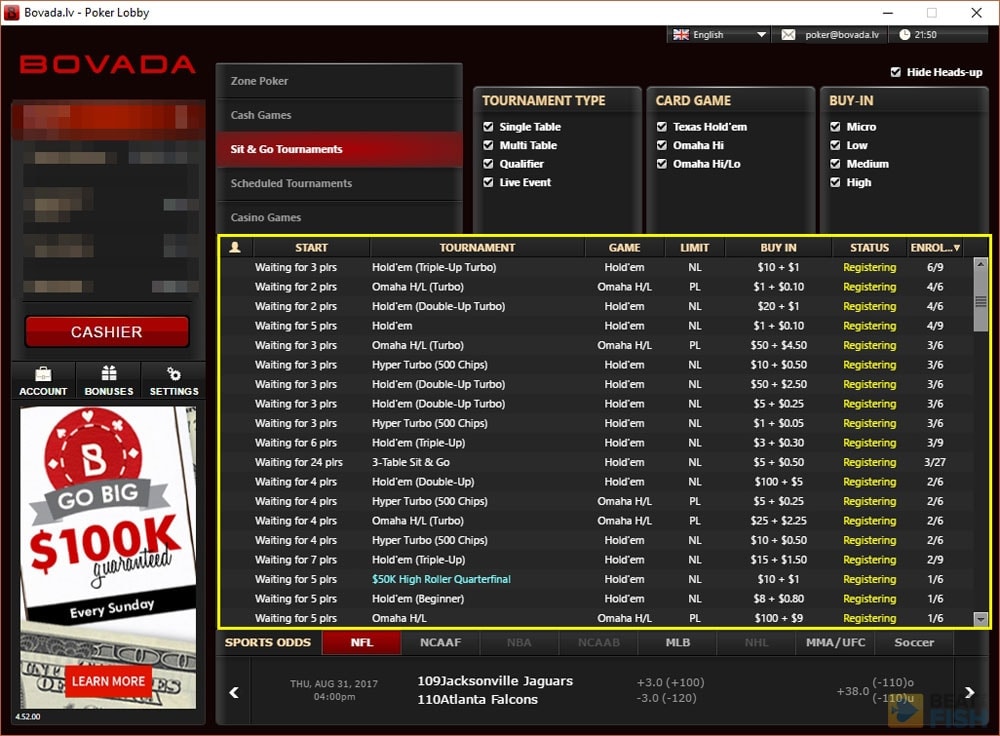50 50 Sit And Go Online Poker
Overview And Strategy Primer for The Fifty50 SNGs At Pokerstars
What to look for in a good sit and go poker room. Every online poker room offers SNG tournaments (sometimes referred to as STTs).I could just cobble together any old list of random rooms and call them the 'best poker sites for sit and gos'. Sit & Go Poker Tournaments. A Sit & Go tournament is a poker tournament with a pre-defined number of players (varying from 2 to 120), which begins once all of its seats are filled. To learn how to join a Sit & Go tournaments, please see Join a Tournament, in the Getting Started section of this site. Members may register to a maximum of six.
With Pokerstars taking the controversial decision to close their popular Double or Nothing SNGs, their replacements – known as Fifty 50 SNGs – have sweetened the pill for many players. This article gives you an overview of what is available and how the structure works for the new format, and then looks at some high level factors which affect your strategy for these games. I’ll finish up with a summary and share my opinion on whether these games are a good choice for different types of player.
Fifty 50 SNGs At Pokerstars – How They Work And What Is Available
Fifty 50 SNGs end when there are 5 of the original 10 entrants left. At this point half of the prize pool (basically your entry fee minus the rake) is paid out to the winners. The remaining half of the prize pool is paid according to the number of chips you hold when the game ends. This gives players an incentive to accumulate chips – the inclusion of Antes at the 40 / 80 blind level onwards also makes it less desirable to try and fold into the money.
Only 10 player NL Holdem games are featured at the moment. With a wide range of buy-in levels from the micros up available, turbo (3 minute blinds) and standard (6 minute blinds) are running. I expect to see the variations increase once these games are established.
Rake (fees) are smaller than for standard SNGs with the Turbo games having a smaller fee than the standard speed games. Fees are higher than for the equivalent DoN SNGs.
Fifty 50 SNG Strategy – Some Thoughts On Approaching These Games
Rather than go into hand-level specifics, I’ll focus on my usual two key factors for strategy – opponents and the prize pool structure.
Opponents at the lower levels will make big enough mistakes to make the games profitable for you just by playing solid poker. At the mid-stakes and above you will need to identify and exploit the weaker players, and adjust to the the tendencies of the grinders too. In my view the key to exploiting opponents in these games is to identify those who understand how the prize pool affects their end-game on a conceptual level, at the detailed level (have checked the math!) and not at all. Each of these players have different push-fold ranges… and if you know an opponents ranges you can find out the most profitable adjustment.

50 50 Sit And Go Online Poker Games
Planet Mark's Rec: If you want to know the bubble math well enough to be consistantly profitable - then an ICM Calculator is a must. ICMIZER 2 is my personal rec, once you plug in some numbers you'll be able to spot profitable call / fold / all-in spots easily (when back in the games). This is available via a low price monthly subscription, and willl pay for itself over and over again! Check out www.icmpoker.com for more info, you'll crush the Fitfty50 games fast!
The prize pool makes your approach more complex than in the old Double Of Nothing SNGs. Getting your buy-in back for finishing in the money is not going to cut it long-term, though could be a good result in an individual game if you end up short and an opponent busts before you do.

Having a big stack at the bubble is a different proposition in these games, you can use this stack in 2 ways. Firstly you should be stealing blinds often, the mid-stacks will not play back often for fear of busting – especially when there is a small stack at the table. You might even want to keep the bubble alive by giving the shortest stacks a walk to let you pound on the mid-stacks even more!
With a big stack you can often call a little lighter too, here is an example of the thinking:
A small stack on the button pushes for 1200 and you have 7500 chips in the BB after posting a 300 blind, this means you are calling 900 to win 1740 (antes in play). Here the small stack is desperate and should be pushing very wide, your chances of bubbling would not be seriously affected by losing the hand, and best of all – you are getting 1.9 to 1 on your call with the opportunity to pick up extra cash those times you win… the small stack is risking his ‘survival’ equity, the big stack is simply making a chip ev calculation.
When we compare bubble calling ranges in the Fifty 50 SNGs with Double or Nothing the biggest contrast is that those ‘never call’ situations are fewer. In a DoN it was routine (and profitable) to fold QQ to a shove, even when you ‘knew’ your opponent could be pushing any-2. In Fifty 50 games those chips (and the blinds / antes) have a value, and this value will translate into a wider calling range. How wide will depend on several factors including the size of the blinds, stack sizes and presence of one or more ‘micro-stacks’. If you are planning on specializing in these games then you’ll need to run the scenarios through SNG Wiz.
Early Game – Play Looser?
A key question for approaching these games is whether the need to accumulate chips should see us loosen up early? My view is that the most important factor is maintaining fold equity (ability to get opponent to fold to your all-ins) close to the bubble. Taking the chips from the weaker players and developing a chip stack with which to bully the bubble with are nice, but secondary. The ‘super-nit early / crazy shove (but not call) late’ strategy that was successful in the Double or Nothings is a little too extreme – however I will not be loosening up too much in these games.
Sit N Go Poker
Pokerstars Fifty 50 SNG Strategy – Final Thoughts / Next Steps
The more skillful bubble play in these games suggest that the regulars will be playing less tables than in the DoN SNGs they are replacing. It is early to say whether these games will prove as popular as their predecessors once the buzz / newness wears off.
My view is that these will be profitable for those players who are able to adjust, and very profitable for those prepared to put in the work to understand the ICM dynamic and spot the leaks in their opponents ranges.
If you are looking for a steady income from SNG tournaments, then the ‘normal’ structure is still very beatable. My 4-part course, ‘The $16 per hour SNG Blueprint’ is freely available to all readers and takes you through the steps required to become a regular SNG winner over 4 weeks. You can read the preview and register here.
Further Reading On / SNGs
If you’re looking to experience some fast-paced poker action and improve your skills at the same time, you may want to consider an online sit and go tournament. This popular option combines the real-money play of a ring game with the attrition and prize structure of a multi-table contest.
For those who are new to the world of Internet gambling, this article is meant to familiarize you with sit n gos online. We’ll cover the basic format of the tournament, all pertinent rules, as well as offering a number of tips to help you come out on top.
What is a Sit and Go Game?
A Sit and Go tournament is also known as an SNG or SitnGo. These games are contested between six and 10 players, and the usual length runs from 20 to 60 minutes. The cost of entry varies from one tournament to another, but they can range from less than $1 to more than $1,000.
50 50 Free Online
The name “sit and go” is derived from the fact that these tournaments begin as soon as all seats at a table are taken. Games fill up fast, which is why most online card rooms have them scheduled in steady succession throughout the day.
In order to enter the tournament, a player has to pay a specified buy-in amount. Just like in a cash/ring game, this amount equals the starting chips for all participants. If, for example, a table requires a $20 buy-in, then each player begins the game with $20 in chips.
Gameplay continues until only one player remains. At this point, the tournament is over and those who finished in the money receive their payout. There are no re-buys in these games; when your stack of chips has been depleted, you’re eliminated from the contest (known as a “freezeout tournament”).
Sit And Go Poker Tournaments
The top three players usually receive a cash prize, although this is sometimes reduced to two in smaller games. In a game where 10 players each contributed $20, for example, the prize breakdown might be something like this: $100 to first place, $60 to second place, and $40 to third place.
In addition to the faster pace of the game, players are put under pressure by the presence of an increasing blind structure. The big and small blinds traditionally rise every 10 hands in a 10-player game, and this has a great impact as the rigors of the tournament begin to whittle away at the stacks. The most noticeable effect is that players are forced to play less-than-optimal hands in the latter stages of the game.
Sit And Go Poker Meaning
In multi-table tournaments, a player competes at a table until they’re the only one remaining, and then they move to another table where fellow winners have gathered. This continues until the surviving players compete at a final table. While this structure can be found at some sit and go games, most of these tournaments are limited to the players at a single table.
How to Win a Sit n Go Tournament
There are a number of qualities needed to win a sit n go tournament, and don’t forget that luck also plays a factor. While there’s nothing I can do to help with the latter, the following tips should give you a better chance of finishing in the money.
During the early stages of the tournament, it’s wise to adopt a conservative strategy. This means avoiding big chip confrontations whenever possible, and only being aggressive when you have a premium hand. Remember: tight is right in the early levels.
If you’re playing in an early position during a hand, you should be as tight as possible. If you commit money on a weak hand, you could wind up being forced out by the time the betting gets back to you. In a game with such small stacks, the chips you just wasted could wind up costing you dearly.
Sit And Go Poker
During the middle stages of a sit n go, it’s recommended that you adopt a more aggressive strategy to put pressure on your opponents and add to your stack. Don’t be afraid to go after small pots, re-raise, go all-in, and steal blinds. Don’t get carried away, though, especially when you have a marginal or speculative hand.
The middle stages are also a good time to remember the “gap concept.” This means you can open the pot more frequently and with more mediocre hands than you can call with.
Keep an eye out for the “money bubble,” which is the phase of the tournament where only four players remain. Once one of these individuals has busted, everyone else is guaranteed of finishing in the money. Use position to your advantage at this point, play aggressive, and try to exploit those with shorter stacks.
In the latter stages of the game, you’re considered short-stacked if your total is six times less than the amount of the big blind. If this happens, you need to work on improving your stack as soon as possible, and the best way to do this is to target other survivors with small stacks.

If you have the misfortune of being short-stacked when only four players remain, there’s nothing wrong with looking for an opportunity to go all-in. You’re likely to get called because of your smaller chip count, so wait until you have a hand that’s well-suited for a showdown.
During the final stages of the game, don’t play too tight. The large blinds are going to erode your stack at an alarming rate, so you’ve got to get in there and do some damage. Open as many pots as possible, and don’t be afraid to re-raise.
No matter what stage the tournament is in, always try to get a feel for your opponents. This is a must in any type of competitive poker game, as it allows you to predict possible behavior and capitalize on it. For example, weak players are prone to fold when raised, while overly aggressive players raise with marginal hands and are less likely to shy away from a bluff.